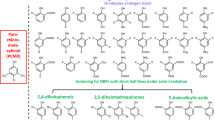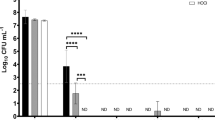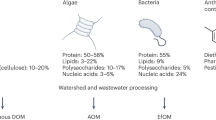Key Points
-
This article studies the stability of Sterilox solutions and some factors that might cause changes in chlorine concentration and pH
-
Sterilox was found to be stable for a 14-day period when stored in ideal conditions
-
Sunlight exposure accelerates the decomposition rate of chlorine
-
The presence of air in the bottle does not influence chlorine decomposition
Abstract
Super-oxidised waters, particularly Sterilox®, have been suggested for the disinfection of dental unit water lines and dental impression materials owing to their antimicrobial efficacy. One of the previously suggested characteristics is their short shelf life. The purpose of this investigation was to understand the effect of storage conditions on Sterilox®'s stability. Eight bottles (four completely full, four half-full) of freshly prepared solution were divided into four groups and subsequently stored by being either exposed to or protected from sunlight. The chlorine concentration was monitored using chlorine test strips until the concentration reached zero, or until the thirteenth week. Statistically significant differences between the groups exposed to sunlight and the non-exposed groups (p <0.001) were found. The mean loss of chlorine per day for the non-exposed samples was 1.01 mg/L, whilst the mean for the exposed samples was 2.42 mg/L. The presence of air did not affect the chlorine decomposition in the bottles. The results of this investigation indicate that when the solution is exposed to sunlight, the decrease of chlorine starts at day 4, whilst for the groups sheltered from sunlight, the process started after day 14. Therefore, Sterilox® solutions appear to be more stable than previously surmised.
Similar content being viewed by others
Log in or create a free account to read this content
Gain free access to this article, as well as selected content from this journal and more on nature.com
or
References
Martin M V, Gallagher M A . An investigation of the efficacy of super-oxidised (Optident/Sterilox) water for the disinfection of dental unit water lines. Br Dent J 2005; 198: 353–354.
Martin N, Martin M V, Jedynakiewicz N M . The dimensional stability of dental impression materials following immersion in disinfecting solutions. Dent Mater 2007; 23: 760–768.
Marais J T, Williams W P . Antimicrobial effectiveness of electro-chemically activated water as an endodontic irrigation solution. Int Endod J 2001; 34: 237–243.
Solovyeva A M, Dummer P M . Cleaning effectiveness of root canal irrigation with electrochemically activated anolyte and catholyte solutions: a pilot study. Int Endod J 2000; 33: 494–504.
Shetty N, Srinivasan S, Holton J, Ridgway G L . Evaluation of microbicidal activity of a new disinfectant: Sterilox 2500 against Clostridium difficile spores, Helicobacter pylori, vancomycin resistant Enterococcus species, Candida albicans and several Mycobacterium species. J Hosp Infect 1999; 41: 101–105.
Selkon J B, Babb J R, Morris R . Evaluation of the antimicrobial activity of a new super-oxidised water, Sterilox, for the disinfection of microscopes. J Hosp Infect 1999; 41: 59–70.
Loshon C A, Melly E, Setlow B, Setlow P . Analysis of the killing of spores of Bacillus subtilis by a new disinfectant, Sterilox. J Appl Microbiol 2001; 91: 1051–1058.
Zinkevich V, Beech I B, Tapper R, Bogdarina I . The effect of super-oxidised water on Escherichia coli. J Hosp Infect 2000; 46: 153–156.
PuriCore plc. How PuriCore's technology works. Available at http://www.puricore.com/technology_works.aspx.
Rutala W A, Cole E C, Thomann C A, Weber D J . Stability and bactericidal activity of chlorine solutions. Infect Control Hosp Epidemiol 1998; 19: 323–327.
Ayliffe G, Minimal Access Therapy Decontamination Working Group. Decontamination of minimally invasive surgical endoscopes and accessories. J Hosp Infect 2000; 45: 263–277.
Landa-Solis C, González-Espinosa D, Guzmán-Soriano B et al. Microcyn: a novel super-oxidised water with neutral pH and disinfectant activity. J Hosp Infect 2005; 61: 291–299.
Lee S-V, Hung Y-C, Chung D, Anderson J L, Erickson M C, Morita K . Effects of storage conditions and pH on chlorine loss in Electrolyzed Oxidizing (EO) Water. J Agric Food Chem 2000; 50: 209–212.
El Din A M S, Arain R A, Hammoud A A . On the chlorination of seawater. Desalination 2000; 129: 53–62.
Shimada K, Ito K, Murai S . A comparison of the bacterial effects and cytotoxic activity of three types of oxidizing water, prepared by electrolysis as chemical dental plaque control agents. Int J Antimicrob Agents 2000; 15: 49–53.
Clark J, Barrett S P, Rogers M, Stapleton R . Efficacy of super-oxidized water fogging in environmental decontamination. J Hosp Infect 2006; 64: 386–390.
Cooke R P D, Goddard S V, Whymant-Morris A, Sherwood J, Chatterly R . An evaluation of Cidex OPA (0.55% ortho-phthaldehyde) as an alternative to 2% glutaraldehyde for high-level disinfection of endoscopes. J Hosp Infect 2003; 54: 226–231.
Author information
Authors and Affiliations
Corresponding author
Additional information
Refereed Paper
Rights and permissions
About this article
Cite this article
Rossi-Fedele, G., Dogramaci, E., Steier, L. et al. Some factors influencing the stability of Sterilox®, a super-oxidised water. Br Dent J 210, E23 (2011). https://doi.org/10.1038/sj.bdj.2011.143
Accepted:
Published:
Issue date:
DOI: https://doi.org/10.1038/sj.bdj.2011.143



